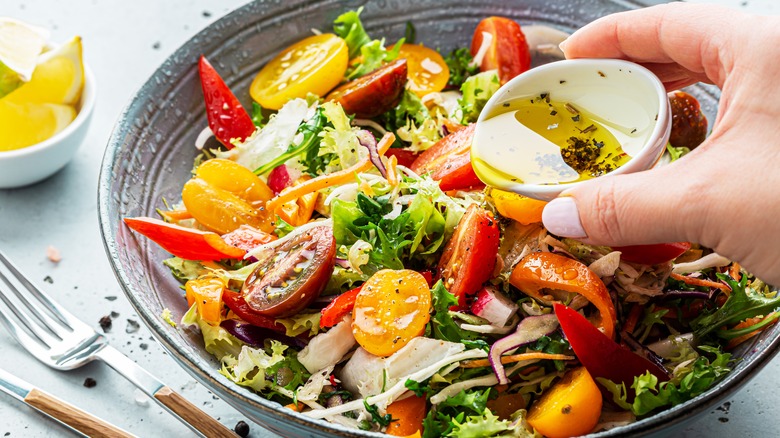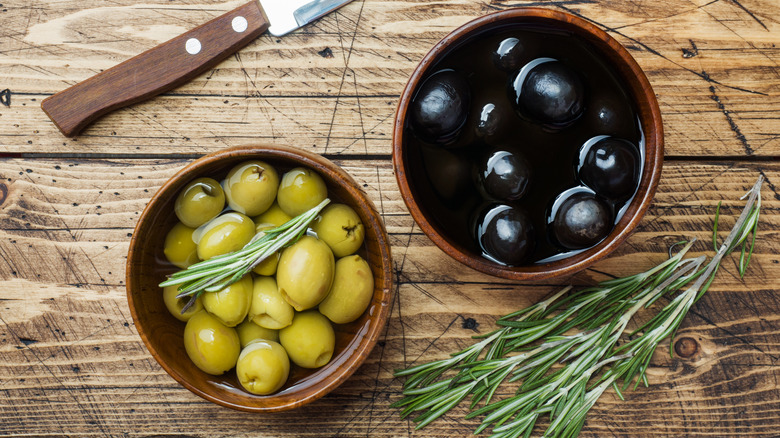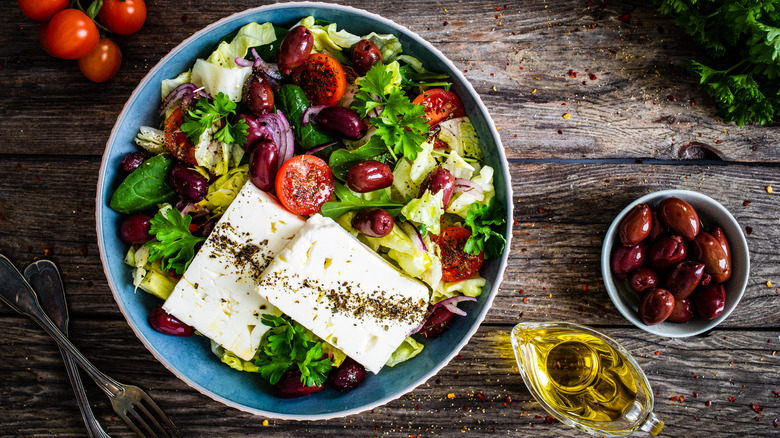Your Salad Dressing Is Missing One Hugely Flavorful Add-In
Dressing your salad can be the tastiest part of this meal. Sure, the leafy greens, crisp cucumbers, firm cherry tomatoes, and whatever else you like to put in this healthy favorite are delish, but if you are looking for ways to upgrade your homemade salad dressing, there's one ingredient lurking in your fridge you may be overlooking that you should be adding: Olive brine. This simple liquid, which either gets tossed or left in the back of the fridge to be forgotten, is packed with a punch of flavor and can turn a basic vinaigrette or a creamy dressing into a gourmet version of its basic self.
Most brines are made of salt, vinegar, and water, but when you add something like olives to this liquid bath, they impart their flavor to the brine, creating layers of richness. A vinaigrette is comprised of one part acid — like vinegar — to three parts oil, and flavored to taste. When you add olive brine as the flavor, it creates a balance between the savory elements and the acid, hitting all the right notes for your mouth. Round it out with some herbs and spices and you have the perfect finishing touch for your salad.
Because brine contains vinegar, you can replace the acid in your vinaigrette with the olive juice or use both ingredients together. You will just want to adjust the amount of each so the end result doesn't make your mouth pucker.
Use black or green olive brine
If you are going to add olive brine to your salad dressing, you may want to take a swig before you do so. Some brines are saltier than others. A quarter cup of green olive brine is a good starting point. If you are adding other salty ingredients to the mix like mustard, bacon, or capers, you may need to adjust this amount or you might be reaching for a glass of water.
Green olive brine isn't the only olive juice you should be reaching for. Black olive brine can be added to your salad dressing as well, but just know green olives and the brine they soak in are going to have a much saltier taste than that of black olives. And if you are making a warm dressing, keep in mind that when you warm olive brine, or any brine for that matter, it is going to concentrate the salt, making for a really potent taste.
If you are making a creamy dressing to drizzle over a grilled marinated flank steak and romaine salad, it should be lush and slightly thicker than a vinaigrette. This is why if you are going to add this salty liquid to this dressing, you want to add just a tablespoon or two of olive brine, so it doesn't become too thin. It will still have a lovely olive flavor, but just a bit milder and more subtle.
Try other brines
You can use your olive brine salad dressing to dress a Greek salad, sprinkle it over roasted vegetables to complement their sweet flavor, or get a little creative. Change up your simple potato salad and use your homemade olive brine vinaigrette to dress this classic side, or try it in your next pasta salad for a punchier bite. If you are saving a jar of leftover olive brine in the fridge and wondering how long you should keep it, the answer is about two months after eating up all the olives. Also keep an eye out for any mold or changes in odor.
Olive brine isn't the only juice on the block that you can use to add a big burst of flavor to your salad dressing. You can use leftover pickle juice to amplify your vinaigrette or even the brine from banana peppers. The vinegar, mustard seed, celery seed, and sugar, along with the flavor of the banana peppers, will add all the tang, zest, and flavor you need to create a unique and delicious dressing for your salad.
And if you are looking for a little spicy kick for your vinaigrette, don't forget the jalapeño brine. If it is too hot for your taste buds, you can tame it by adding some caraway seeds to your dressing.


